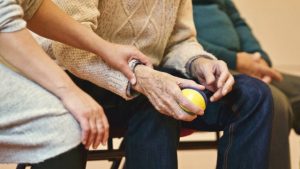You probably have a loved one who is elderly and as you know, unlike for younger people falls are a real risk for the elderly. Below are some ways in which you can lower your risk of falling by keeping healthy and active along with what to do if you do experience a fall.
Remain healthy
 To maximise your bodily health and reduce your risk of experiencing a fall:
To maximise your bodily health and reduce your risk of experiencing a fall:
- Speak with your Physician or other caregivers around:
- Your daily diet
- Managing your drugs (like non-prescription ones)
- Techniques to manage chronic health conditions, including Nausea and incontinence.
- Have your eyes examined yearly.
- Come to your podiatrist frequently to minimise foot issues.
- Wear shoes that are comfortable and fit nicely — they ought to Be broad enough at the toe region, have no or low heels and possess slip-resistant soles.
- Think about wearing hip protectors or limb guards to help prevent hip fracture and skin rips in case of a collapse. Medical equipment rental can be cheap and offset by private health insurance of Medicare/Medicaid
- Ensure Your vitamin D amounts are sufficient for strong bones And muscles
- Eat a nutritious diet and drink lots of fluids.
- Get active. Research shows that exercise at any given age is beneficial.
Physical activity/exercise

The busier you are the greater your chance of maintaining your muscles strong and joints and also keeping flexible.
To prevent falls and injuries from falls, exercise to keep or enhance your balance, flexibility and strength. House or group exercise plans and tai chi are great examples. Or you may join a walking group or the neighborhood health club — a few of which contain programs specifically tailored to elderly folks.
Check with your GP before beginning a physical activity program. A physiotherapist will help design an exercise program that is suitable for you and could recommend alternating therapy as a solution if you’re already injured or quite ill.
Things to do if you fall in your home
In case you happen to have a fall at home
- Do not worry — remain still for a few minutes and try to calm down.
- Call for assistance if you’re able to. Dial triple zero (000) for emergency services or telephone your Local physician for help — maintain your phone in easy range of the ground, for example on a low table.
- Choose whether it’s possible to get yourself up.
If you can get yourself up
- Roll over on your belly and try to get into a running position.
- Crawl onto a secure piece of furniture, like a sofa chair.
- Attempt to get up on your knees.
- Push upward, using your strongest arms and leg, still firmly Holding on the furniture.
- Sit down on the furniture.
- Visit your doctor to check for injuries and also to evaluate whether There was a medical foundation for the collapse.
If you cannot get up on your own
- Attempt to crawl or haul to someplace on carpeting and Locate whatever may prevent you from getting cold, like bedclothes, a towel or clothes, as you wait for assistance.
- Utilize your private alarm, in case you have one.
- If you do not have a private alarm, use a thing which you can bang to produce a loud sound, such as a walking stick against the walls, to awake a neighbour.
- If you know nobody will hear you, then keep warm and try to get up again after some time.
- Visit your doctor to check for injuries and also to evaluate whether there was a medical foundation for the collapse.
Where to get Assistance
- Your Regional physician or health professional
- Local community wellness services
- Falls and Mobility Clinics – get in touch with your regional Department of Human Services office
- My Aged Care — Aged Care Information Line Tel. 1800 200 422
- Commonwealth Respite and Carelink Centres Tel. 1800 052 222
- Carers Australia Tel. 1800 242 636
- Seniors Information Victoria Tel. 1300 13 50 90
- Independent Living Centre Victoria Tel. -LRB-03-RRB- 9362 6111
Things to remember
- Falls are a significant source of injury for older people.
- Falls might be an indicator of a medical state.
- Exercising can help preserve strength (bone and muscle) and Equilibrium.
- Taking steps in and around your home can allow you to prevent Falls and injuries from falls.



